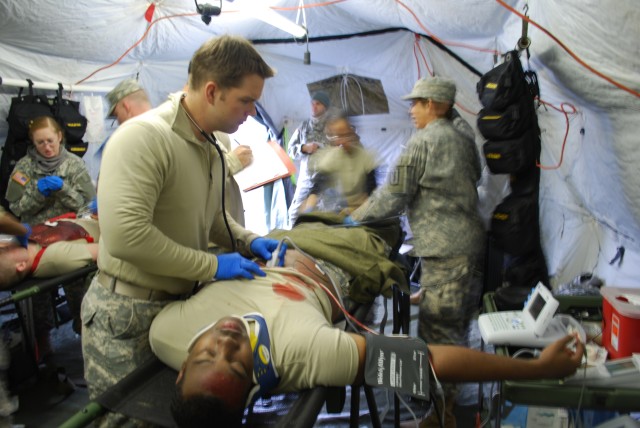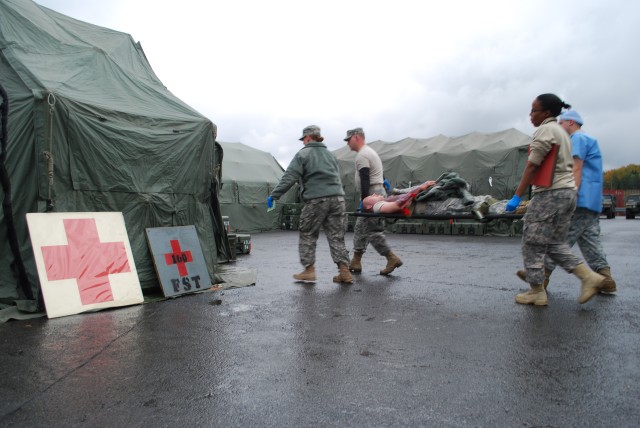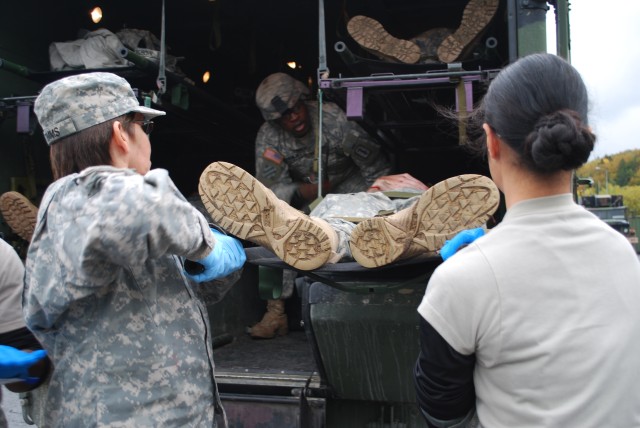Though they dread the rush of Wounded Warriors on blood-soaked gurneys, they are ready. Though they would prefer their medical skills were unnecessary, that surgical tools remain clean and unused, today's fight calls for Army Forward Surgical Teams to remain sharp and vigilant, prepared for their mission - saving Soldiers. Able to move out and be emplaced strategically forward on the battlefield, the members of a forward surgical team can set up and be prepared to work in a matter of hours. With that mission in mind, the Soldiers of the 160th Forward Surgical Team deployed to the Joint Multinational Readiness Center at Hohenfels, Germany recently to polish their skills and gain valuable experience training together while also working closely with the 212th Combat Support Hospital. The exercise enabled the Soldiers of the FST to assemble their three-tent, Level II facility, and be prepared to receive patients during the notional events taking place around the JMRC training area. A "Level II" medical treatment facility, the FST is exactly what its name suggests - an expeditionary surgical capability that can be established close to the war fighter in order to provide life-saving surgery. Self-sustainable for 72 hours or approximately 30 patients, the team brings the operating room, or tent, to the front. "The FST is able to move to a site and be ready to work in two hours," said Maj. Brandon Brown, 212th CSH general surgeon. Ready to work means ready to receive Soldiers in need of immediate and critical medical care. The members of the FST perform necessary live-saving steps to stabilize them so that they can be moved to a higher medical facility, such as a combat support hospital. When a call on the radio broke through the calm of the FST, everyone on the team swiftly moved into action in preparation for receiving three "injured troops" during the training. The vehicle's doors swung open to reveal three pairs of boots. The mock-casualties were quickly unloaded and rushed into the FST for care. "As soon as they come in, we are evaluating," explained the 160th FST Commander, Maj. Ruth Timms. "If they don't need to go to the [operating room], we stabilize them and immediately call for MEDEVAC. We only have eight beds and these patients are still critical and need to move to Level III care." Amidst the visible chaos inside the tent, the Soldiers of the team moved with calm and swift precision. Every member of the team has a function and together things flowed seamlessly as the casualties were stabilized and prepared for their evacuation to the CSH. The 160th FST Detachment Sergeant, Sgt. 1st Class Teresa Isaacs, says that the tempo of working in the FST can be rapid, but working such a fast-paced mission with such a small group builds a strong bond. "I'm used to being with a CSH," said Isaacs. "[The FST] has most of the same capabilities, just on a smaller scale and it's a little faster. The teamwork is awesome. There are only about 20 of us so we become like a big family." Though they would prefer to be unoccupied, the FST Soldiers realize that training like this and being prepared is essential. "We would certainly rather not be busy, because if they are coming to see us than something bad has happened." said Spc. Ariane Denham, an army licensed practical nurse. "But with our job, you can never stop training - you have to stay fresh."
Forward Surgical Team demonstrates calm, swift precision
By Sgt. 1st Class Christopher FinchamNovember 2, 2009






Social Sharing